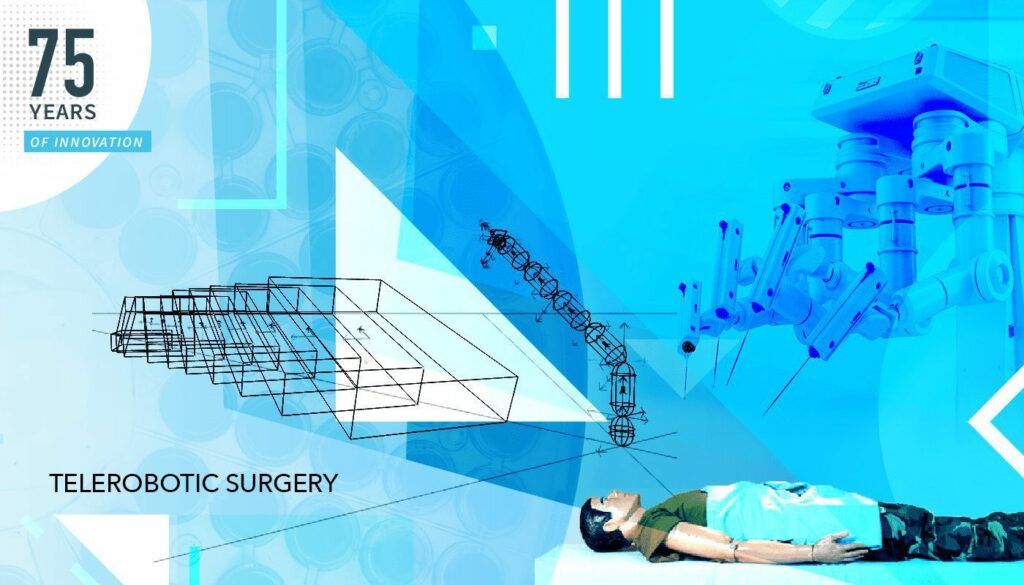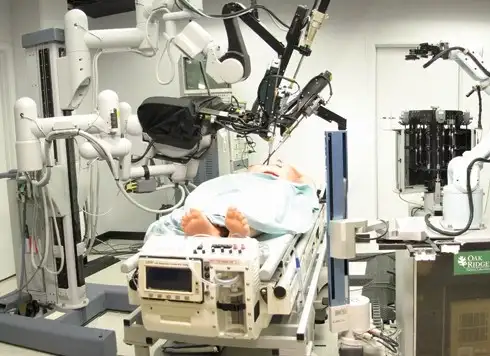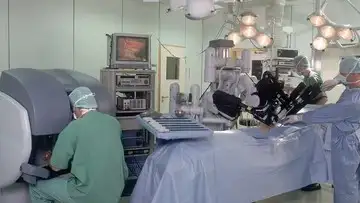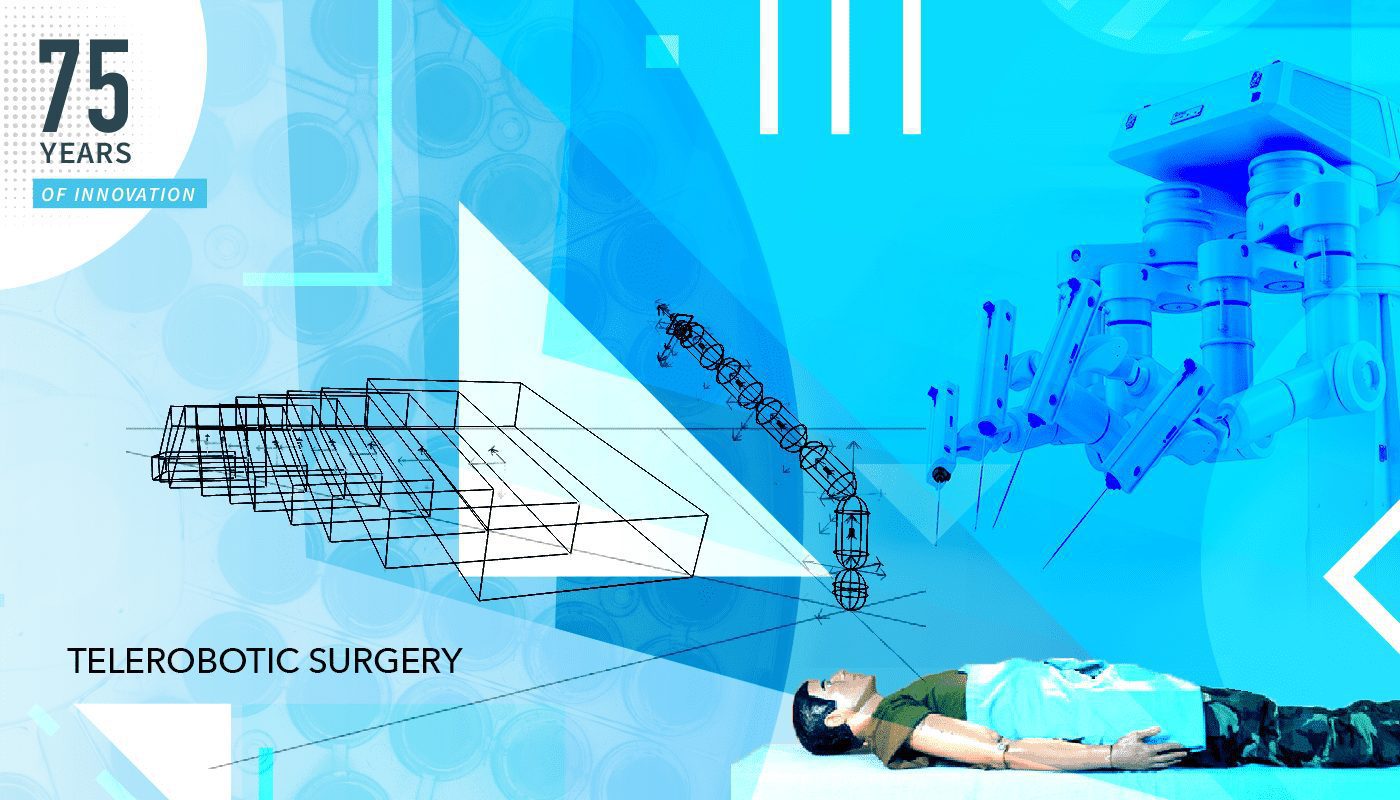The 75 Years of Innovation series highlights the groundbreaking innovations spanning from SRI’s founding in 1946 to today. Each week, SRI will release an innovation, leading up to its 75th anniversary in November 2021.

World’s first commercial robotic surgical system for remote surgical applications
As easy as peeling a grape: Robots enter the operating room
About 7000-years ago, some poor soul had a large hole cut into their skull. Evidence for this form of Neolithic neurosurgery is found in 5–10% of all Neolithic skulls excavated.
Surgery, thankfully, has come a long way since then. Modern anesthesia has taken the ‘sting’ out of the cut. But surgery is a discipline based on the best tools for the job wielded by the best surgeon for the task.
In 1995, SRI International created a spin-off company, Intuitive Surgical, Inc. The company licensed SRI’s technology along with a robotic surgery system that came to be known as the daVinci® Surgical System. In 2010, a video was published showing the da Vinci system peeling a grape. This is how this most delicate of operations was performed.
How a surgeon’s knife is wielded by a robotic arm
Laparoscopic surgery or ‘keyhole surgery’ has been revolutionary in terms of patient care, taking modern surgical procedures successfully into the 1980s. As robotics and automation technologies become more advanced, a new movement began in surgery, one that would take the operating theatre and keyhole surgery into the realms of sci-fi.
In the 1980s, Phillip S. Green of SRI International began to experiment with the idea of having minimally invasive surgery. Green was a biomedical engineer and part of the original team behind another SRI advancement in the field of ultrasound. These qualifications proved prescient in combining several SRI technologies into one system that could be used to take surgery to the next level of surgical care and successful patient outcomes.

Green had a dream, that a surgeon could remotely operate an instrument that was the same if not more precise than the surgeon. The original idea was to apply remote surgery in areas where an expert surgeon could not access.
The original prototype comprised of a combination of stereo imaging displays and miniature cameras, as well as the robotics and remote-control systems used to manipulate the robotic arms that held surgical instruments. With financial input from the Department of Defense and the backing of SRI International, the prototype was developed into a commercial entity. In 1995, SRI formed a spin-off company, Intuitive Inc., to take da Vinci out of the battlefield and into operating theatres the world over.
Leonardo would be proud of the da Vinci® surgical system
Surgery is a scary thing at the best of times. When a patient lies on the surgeon’s table, a high degree of trust is placed in the hands of that surgeon. The use of a robot arm instead of a surgeon’s hand has to pass the ‘trust test’ to allow robotic technology to make the cut.
A robotic surgeon is an extension of a human surgeon, an augmentation of the surgeon’s skills, another tool in the surgeon’s kit. With this in mind, the prototype version that Green and team came up with was named the ‘Green Telepresence System’.
This first pass at making trusted robotic surgeons consisted of two basic parts:
- Telepresence Surgeon Workstation (TSW) and a video monitor
- Remote Surgical Unit (RSU)
The surgeon at the TSW used a stereoscopic video monitor and a pair of instrument manipulators to transmit hand motions to the RSU. The surgeon was able to work in 3D using a pair of polarized glasses with the 120-degree field provided by the monitor and a liquid-crystal display. The RSU contained ‘end-effectors’ which received the output from manipulators and controlled the instrument tips: the tips included forceps, needle drivers, bowel graspers, scalpels, and cautery ends. This prototype went on to be further developed, adding in SRI’s haptic feedback technology.
Intuitive Inc. commercialized the da Vinci Surgical System. Today, da Vinci is used to perform complex operations including cardiac surgery. Keyhole surgery has achieved new levels of detail with incisions as small as 1–2 centimeters.

Da Vinci has four robot arms. Each arm has a dedicated microtool for manipulating, cutting, cauterizing, and suturing. The robot arms sit on a movable cart next to the patient operating table; the surgeon is in a sophisticated, ergonomically designed control console, using a magnified three-dimensional (3D) view of the operating field. In providing precisely controlled micromovements, da Vinci has made the range of motion of the robotic arm greater than the human wrist.
Intuitive Surgical Inc.’s da Vinci Surgical System is now the most widely used, multipurpose robotic surgery system in the world.
The da Vinci Surgical System was the first robotic-assisted system in the world to receive US Food and Drug Administration (FDA) approval for laparoscopic surgical use.
Further into the field of robotic surgery
SRI, working with the U.S. Defense Advanced Research Projects Agency (DARPA) led the “Trauma Pod Project”. This was an initiative to make semi-autonomous surgical units, where patients could be operated upon by surgeons many miles from the front line. The project utilized the da Vinci Surgical System and augmented it further to create operating rooms that could function with only the patient present. The solution was able to:
- Capture 3D patient scans and vital signs
- View simulated CT images to diagnose an injury
- Suture a simulated bowel section
- Place a shunt in the groin of the patient
- Create a comprehensive record of the procedure
The surgeon demonstrated critical tasks performed with 100% accuracy during tests of the system.
SRI is now developing a robotic surgeon that uses a consumer virtual reality (VR) headset and controller. Named Taurus, this could be a new generation of robotic surgeons that may well be used in space.
Intuitive’s da Vinci Surgical System is used in 10s of thousands of procedures every year. Like much of the work of SRI International, the da Vinci Surgical System is a convergence of thoughts, ideas, technology, and deep expertise. This time, it helps both surgeons and patients to achieve a better outcome from an often impactful or life-threatening condition.
Resources
Reddy RM, Gorrepati ML, Oh DS, Mehendale S, Reed MF. Robotic-Assisted Versus Thoracoscopic Lobectomy Outcomes From High-Volume Thoracic Surgeons. Ann Thorac Surg. 2018;106(3):902–908. doi:10.1016/j.athoracsur.2018.03.048
Da Vinci Surgical System peeling a grape: https://www.youtube.com/watch?v=KNHgeykDXFw
Intuitive da Vinci Surgery: https://www.davincisurgery.com/
George EI, Brand TC, LaPorta A, Marescaux J, Satava RM. Origins of Robotic Surgery: From Skepticism to Standard of Care. JSLS. 2018;22(4):e2018.00039. doi:10.4293/JSLS.2018.00039
The Dish, 75 Years of Innovation: Ultrasound: https://medium.com/dish/75-years-of-innovation-ultrasound-1999c724f750
YouTube, How da Vinci surgery works: https://www.youtube.com/watch?v=QksAVT0YMEo



